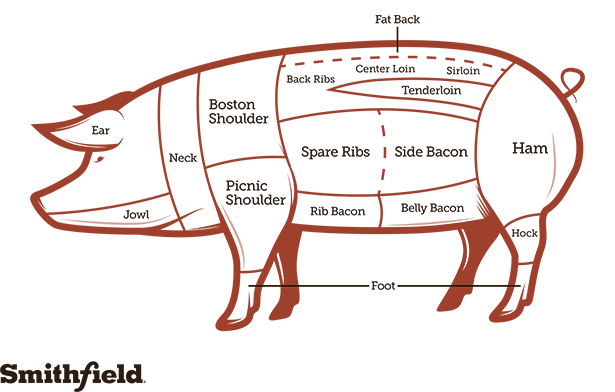Shoulder
Also referred to as Boston blade roast or Boston butt, this meltingly tender, well-marbled cut can be roasted whole, cut up for stews or cooked in a smoker and transformed into deliciously flavorful pulled pork.
Ground Pork
The flavorful shoulder meat is ground or finely chopped to create ground pork. This is used in many standard pork-specific dishes, or as a moist, healthy recipe alternative for any ground meat.
Tenderloin
A very juicy, tender cut, the tenderloin is the king of versatility. Its delicate flavor makes it the perfect companion for a spicy rub, marinade or sauce. Tenderloin is an easy option for entertaining, or a quick family meal.
Pork Chops
There are a lot of great offerings between the hip and shoulder; all chops, all delicious—loin, rib, sirloin, top loin and blade. Chops are the user-friendly, easy-to-prepare cut of pork that offers endless meal options.
Loin Roast
Located along the back between the shoulder and the leg is a cut of pork that is worth celebrating. And in fact, many people do. Brining, barbecuing or stuffing a loin roast will always result in a fantastic presentation and delectable taste.
Back Ribs
Just as the name says, this is the back rib section, where the tender finger meat lies. Many rubs and sauces claim to define baby back ribs, but it’s the tender, juicy, fall-off-the-bone quality that is the real winner of this cut.
Spareribs
This is a long cut consisting of 11-13 of the lower ribs. Because of the larger bones, spareribs must be cooked longer allowing the juicy fat to melt into the meat. Any sparerib lover will tell you, they are worth the wait.
Crown Roast
The majestic crown roast makes any meal a special occasion. The elegant, yet simple “crown” is created by tying a pork rib roast into a circle, making sure the bone is exposed. No centerpiece needed when this roast is around.
Offal & Lard
For generations, people have enjoyed offal in its many forms: jowls, feet, hocks, fat back, organ meat and entrails. These share the flavor spotlight with lard, or rendered pork fat, tastier and healthier than saturated fats in the market.
Belly
Long known as the section of pig that bacon comes from, the belly has gained in popularity as a delicate, juicy cut on its own. But it is the versatile bacon that surely holds a special place in the hearts and palates of Americans.
Leg Quarter
This section is where ham, an all-time favorite cut, is found. Often cured, smoked or salted, ham is a mainstay meat that not only graces the center of the table at holiday time, but also defines many everyday meals.

